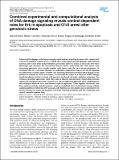Combined experimental and computational analysis of DNA damage signaling reveals context-dependent roles for Erk in apoptosis and G1/S arrest after genotoxic stress
Author(s)
Tentner, Andrea R.; Lee, Michael J.; Ostheimer, Gerard; Samson, Leona D.; Lauffenburger, Douglas A.; Yaffe, Michael B.; ... Show more Show less
DownloadYaffe_Combined experimental.pdf (4.056Mb)
PUBLISHER_CC
Publisher with Creative Commons License
Creative Commons Attribution
Terms of use
Metadata
Show full item recordAbstract
Following DNA damage, cells display complex multi-pathway signaling dynamics that connect cell-cycle arrest and DNA repair in G1, S, or G2/M phase with phenotypic fate decisions made between survival, cell-cycle re-entry and proliferation, permanent cell-cycle arrest, or cell death. How these phenotypic fate decisions are determined remains poorly understood, but must derive from integrating genotoxic stress signals together with inputs from the local microenvironment. To investigate this in a systematic manner, we undertook a quantitative time-resolved cell signaling and phenotypic response study in U2OS cells receiving doxorubicin-induced DNA damage in the presence or absence of TNFα co-treatment; we measured key nodes in a broad set of DNA damage signal transduction pathways along with apoptotic death and cell-cycle regulatory responses. Two relational modeling approaches were then used to identify network-level relationships between signals and cell phenotypic events: a partial least squares regression approach and a complementary new technique which we term ‘time-interval stepwise regression.’ Taken together, the results from these analysis methods revealed complex, cytokine-modulated inter-relationships among multiple signaling pathways following DNA damage, and identified an unexpected context-dependent role for Erk in both G1/S arrest and apoptotic cell death following treatment with this commonly used clinical chemotherapeutic drug.
Date issued
2012-01Department
Massachusetts Institute of Technology. Center for Environmental Health Sciences; Massachusetts Institute of Technology. Department of Biological Engineering; Massachusetts Institute of Technology. Department of Biology; Koch Institute for Integrative Cancer Research at MITJournal
Molecular Systems Biology
Publisher
Nature Publishing Group
Citation
Tentner, Andrea R et al. “Combined Experimental and Computational Analysis of DNA Damage Signaling Reveals Context-dependent Roles for Erk in Apoptosis and G1/S Arrest After Genotoxic Stress.” Molecular Systems Biology 8 (2012). © 2012 Nature Publishing Group, a division of Macmillan Publishers Limited
Version: Final published version
ISSN
1744-4292
1744-4292